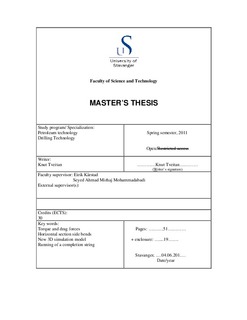| dc.contributor.author | Tveitan, Knut | |
| dc.date.accessioned | 2011-10-29T09:28:25Z | |
| dc.date.available | 2011-10-29T09:28:25Z | |
| dc.date.issued | 2011 | |
| dc.identifier.uri | http://hdl.handle.net/11250/183305 | |
| dc.description | Master's thesis in Petroleum engineering | no_NO |
| dc.description.abstract | Deviated oil and gas wellbore sections keep getting longer. This is due to the fact that more fields are reaching their mature phase and due to the fact that the technical development allows us to. The number of platforms on new projects will be reduced when wells have longer horizontal sections.
In this aspect, the well friction is of importance. The friction forces will be of relevance when considering the tubular limitations in long horizontal wells with respect to the tubular yield strength specifications and buckling tendencies. Long horizontals increase the friction.
This leads to a need for friction prediction models, and they have existed for decades. The models have had their weaknesses, and in 2009 a 3-dimensional friction model was introduced with new features – among these the ability to include forces acting in side bends in the horizontal section of the wellbore. Mirhaj, Kårstad and Aadnøy (paper published in 2010) and Mirhaj, Fazaelizadeh, Kårstad and Aadnøy (paper published in 2010) have done work on the use of this 3-dimensional friction model.
Whereas work up to now with the 3-dimensional excel spreadsheet has been done on the drilling, hoisting and lowering operation of drill strings, this thesis mainly focuses on the hoisting and lowering of strings – one drill string and one completion string.
The correspondence between the 3-dimensional friction model and field hookload data has been examined, and whereas there was a good correspondence between prediction model and hookload data for the particular cases of both hoisting and lowering of a drill string, this was not the case for the operation of lowering a completion string. The 3-dimensional excel spreadsheet does have a feature weakness that may account for some of this discrepancy. Possible effects from surrounding fluids on the pipe in a curved wellbore were also investigated, but no connection between these forces and the reduced prediction model and field hookload data correspondence was found. | no_NO |
| dc.language.iso | eng | no_NO |
| dc.publisher | University of Stavanger, Norway | no_NO |
| dc.relation.ispartofseries | Masteroppgave/UIS-TN-IPT/2011; | |
| dc.subject | petroleumsteknologi | no_NO |
| dc.subject | boreteknologi | no_NO |
| dc.title | Torque and drag analyses of North Sea wells using new 3D model | no_NO |
| dc.type | Master thesis | no_NO |
| dc.subject.nsi | VDP::Technology: 500::Rock and petroleum disciplines: 510::Petroleum engineering: 512 | no_NO |
